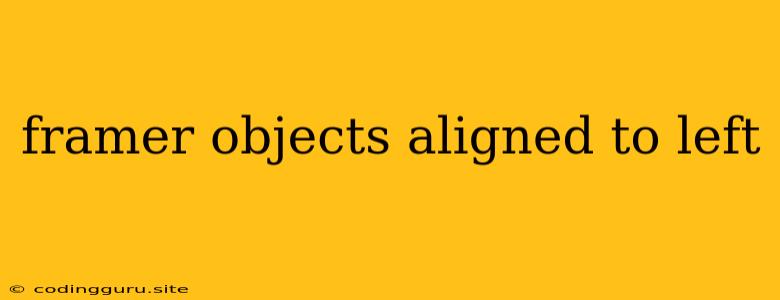Framer Objects Aligned to Left: A Comprehensive Guide
Have you ever found yourself struggling to perfectly align objects to the left edge of your Framer canvas? It's a common challenge, especially when working with multiple elements and maintaining visual consistency. This guide will provide you with a clear understanding of different techniques to achieve left alignment in your Framer projects.
Understanding the Basics
Before diving into the techniques, let's grasp the fundamentals of object alignment in Framer. The concept of "left alignment" implies that the left edge of an object should be flush with the left edge of its container or a specific reference point. This creates a visually structured and organized layout, particularly essential for creating user interfaces (UIs).
Framer's Alignment Tools
Framer offers a variety of built-in tools and properties to handle object alignment. Here's a breakdown of the most useful options:
1. The Alignment Panel:
Framer's dedicated Alignment Panel is your primary tool for aligning objects within your designs. It allows you to align selected objects horizontally and vertically relative to each other or to the canvas itself.
2. The "Align Left" Option:
Within the Alignment Panel, the "Align Left" option is your go-to for positioning objects to the leftmost edge of the canvas or their container. This is a simple and intuitive approach for achieving the desired alignment.
3. The "X" Property:
The "X" property in the object's inspector controls its horizontal position. By adjusting this value, you can directly set the distance between the left edge of the object and the left edge of the canvas or its container.
4. Code-based Alignment:
For more granular control and dynamic layouts, Framer allows you to use code to precisely align objects. By using properties like left, x, and position, you can programmatically position objects to the left edge, ensuring consistent alignment throughout your designs.
Achieving Perfect Left Alignment: Practical Examples
1. Aligning Multiple Objects:
- Select the objects you want to align.
- Open the Alignment Panel.
- Click on the "Align Left" button.
This will position the left edge of all selected objects along the left edge of their container or the canvas.
2. Aligning Text:
- Select the text object.
- In the object's inspector, navigate to the "Text" section.
- Set the "TextAlign" property to "left."
This will ensure your text is left-aligned within its text box.
3. Code-driven Alignment:
const myButton = new Frame({
width: 100,
height: 50,
backgroundColor: "blue",
position: "absolute", // Absolute positioning for precise control
left: 20, // Sets the left edge distance from the canvas
});
myButton.text = "Click Me!";
myButton.textAlign = "center"; // Center text within the button
In this example, the left property positions the button 20 pixels from the left edge of the canvas.
Troubleshooting Common Issues
1. Objects not Aligning:
- Ensure the correct objects are selected.
- Verify that the Alignment Panel is activated.
- Check for any overlapping objects that may be interfering with the alignment.
2. Alignment Doesn't Stick:
- Make sure the objects' "Position" property is set to "absolute" or "relative" to allow precise control.
- If you're using code, double-check the syntax and properties.
3. Unwanted Spacing:
- Review the object's "Margin" or "Padding" properties.
- If using code, ensure that spacing is consistently accounted for in your calculations.
Beyond Basic Alignment: Advanced Techniques
1. Dynamic Alignment:
By using code and interactive controls, you can create dynamically responsive alignment, where objects adjust their positioning based on user actions or screen size.
2. Alignment Grids:
Framer offers an option for creating alignment grids, which provide a visual framework for precisely positioning elements. These grids can help ensure consistent spacing and alignment throughout your designs.
3. Using Layouts:
Framer's layout components, such as stacks, grids, and auto layouts, offer built-in alignment capabilities. These layouts can streamline the process of arranging objects, often making alignment tasks more intuitive.
Conclusion
Mastering object alignment is a crucial skill for any Framer user. By understanding Framer's tools and techniques, you can create visually appealing and professional designs. Remember to utilize Framer's alignment features, code when necessary, and leverage its powerful layout components to ensure perfect left alignment throughout your projects.
